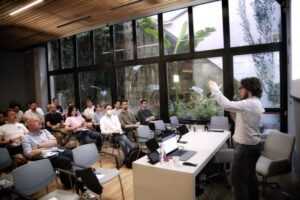MILAN – Today we get to know another of the stars of the coffee world, Jonathan Gagné. He presents himself as a researcher in astrophysics and a passionate coffee geek, with a blog called Coffee Ad Astra and author of the book The Physics of Filter Coffee. Let’s find out what physics has to do with coffee through his scientific experience.
Gagné, you are an astrophysicist: how does coffee relate to this research activity of yours?
“At a first glance coffee and astrophysics might seem like completely unrelated topics, but applying the scientific method to explore unknowns can work in both situations; some of the tools I use to do science in astrophysics, like statistics and programming can be applied directly to coffee when I try to understand what is going on as we brew it.
For example, I used programming to measure the particle sizes that come out from a grinder and better understand how they affect the flow of water in filter coffee and espresso.”
Can you tell us about The Physics of Filter Coffee book: what is inside it about the physics of brewing?
“In this book, I discuss everything that I have come to understand about filter coffee when I went very deep into trying to understand every aspect of it; I discuss how water composition affects brewing and taste, how a grinder, water temperature, and dripper shape can also affect the results, and the mechanics of how water flows through a bed of coffee, and how we can make it flow as evenly as we can to obtain the best-tasting cup of coffee.
I was mainly focused on filter coffee at that time, but a lot of the knowledge related to grinders and the flow of water are also useful for espresso.”
Who is this text aimed at? Is it only for experts or can it also be of interest to beginners?
“It is aimed at people who are passionate about coffee, and want to understand what happens when we brew coffee in deep details.
I have written it for a wide audience, which means you don’t need any science curriculum to read it, but what you will need is a lot of motivation, because I go into long and deep explorations of each topic.”
Gagné, could you explain to enthusiasts and also to many professionals who want to improve themselves, why the chemistry and physics of coffee is important to have control over the quality of the final brewed beverage?
“They are important because they affect what you extract from the coffee particles. It can be extremely surprising how different a cup of coffee can taste by only changing the method of extraction, with the same bag of coffee. This is true because the contact time, water temperature, how even the flow of water is, and water composition can all affect the exact profile of chemicals that end up in the cup of coffee, and small changes in these can have a very large impact on how we perceive the taste of the coffee.”
We have seen that you also have a lot of equipment and tools for extraction and grinding: which are your favourites and for what reasons?

Gagné: “There’s a lot of coffee tools that I really enjoy, some of which are quite expensive. I’ve been using the Weber EG-1 grinder for about three years now and I have been enjoying it a lot for its taste profile and how it allowed me to explore some unusual distribution of coffee particles (it produces very little coffee powder with the particular burr set I am using). I have also learned so much from tools like refractometers, and the Decent espresso machine which allows you to graph everything that happens during an espresso shot. Lately I have also enjoyed using the manual lever Flair 58 machine a lot, especially with the Smart Espresso Profiler built by Gábor Laczkó that allows you to see graphs of your pressure and flow rate.”
What can you tell us about the physics of espresso instead?
“There is a lot to unpack here! One thing I think is still very much under appreciated in espresso is how the viscosity of coffee can impact the flow rate and how it evolves during a shot. Initially the coffee is extremely concentrated (it can be more than 15% concentration), and this makes it super thick and viscous. It is hard to push such a viscous fluid through a coffee bed, and as the shot progresses, the concentration will drop by a large amount and it will become gradually easier to push the coffee through, meaning that either the pressure will go down or the flow rate will go up. This is often interpreted as the “puck falling apart”, but this is absolutely not a valid indication of the puck integrity because of the evolving viscosity.”
Gagné, you have carried out numerous experiments from particle size to temperature: can you tell us about some of them and how they came about?
“Some experiments with very different profiles of particle sizes led me to understand that the smallest particles have a disproportionate impact on how easily the flow of water will flow through a bed of coffee. For example, the average particle size has almost no impact on the flow rate in most contexts, rather, it is how much powder is generated that will drive the resistance to flow. This means that a grinder that generates less powder than average will need a much smaller burr gap, and a smaller average particle size, to obtain enough coffee powder and end up with the same resistance to flow.”
And if you said the words astringency and temperature, how would you comment?
Gagné: “Yes, lately I have realized that temperature plays an important role on the extraction of astringent compounds in coffee. In filter coffee, astringent compounds are almost universally regarded as a negative contribution to the taste profile because they tend to mask everything else about the coffee and make it less complex (in espresso or wine, astringency can be much less bothersome). I now suspect that astringency is caused by large molecules that barely dissolve in water; they can be kept away from our cup of filter coffee if we don’t use pressure or suction, have a thick coffee bed and even flow of water, in order for the coffee bed to filter out these large, undissolved molecules.
There is always a small fraction of these compounds that dissolve in water and go right through the coffee bed though, and this means that if we grind too fine, and liberate too many of these molecules, then the coffee will taste astringent even if we have executed our pour over very well. Currently there is no way around this; grinding too fine will always result in an astringent cup, *unless* we also reduce or brew temperature drastically, for example with 80 Celsius water.
This lower temperature makes the astringent molecules even harder to dissolve, so we can get away with grinding finer, but then the sad part of this trick is that you also get a much less vibrant acidity in your cup of coffee, so while this method can be interesting and allow you to grind extremely fine with very efficient extractions, the taste profile is usually more boring.”
Where are you directing your next projects? On which more technical aspects?
“Right now, I am collaborating with some small coffee companies to help them develop better dripper designs, and I am also doing a lot of experiments on espresso. I also want to help build a much better understanding of the various grinder profiles available right now using the laser diffraction method; I think currently there is many unknowns which makes everyone confused about which grinder they should choose, and I’m hoping this can clarify things for the coffee community.”
















